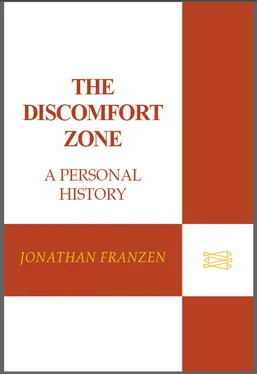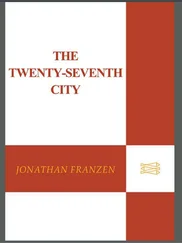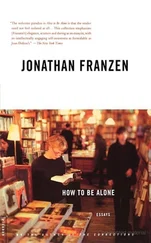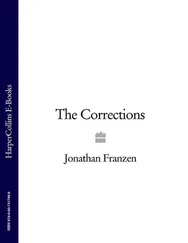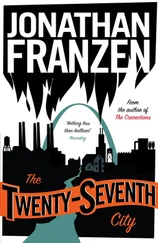Jonathan Franzen - The Discomfort Zone
Здесь есть возможность читать онлайн «Jonathan Franzen - The Discomfort Zone» — ознакомительный отрывок электронной книги совершенно бесплатно, а после прочтения отрывка купить полную версию. В некоторых случаях можно слушать аудио, скачать через торрент в формате fb2 и присутствует краткое содержание. Город: Ney York, Год выпуска: 2006, ISBN: 2006, Издательство: Farrar, Straus and Giroux, Жанр: Современная проза, на английском языке. Описание произведения, (предисловие) а так же отзывы посетителей доступны на портале библиотеки ЛибКат.
- Название:The Discomfort Zone
- Автор:
- Издательство:Farrar, Straus and Giroux
- Жанр:
- Год:2006
- Город:Ney York
- ISBN:918-0-312-94841-2
- Рейтинг книги:3.5 / 5. Голосов: 2
-
Избранное:Добавить в избранное
- Отзывы:
-
Ваша оценка:
- 80
- 1
- 2
- 3
- 4
- 5
The Discomfort Zone: краткое содержание, описание и аннотация
Предлагаем к чтению аннотацию, описание, краткое содержание или предисловие (зависит от того, что написал сам автор книги «The Discomfort Zone»). Если вы не нашли необходимую информацию о книге — напишите в комментариях, мы постараемся отыскать её.
Notable Book of the Year The Discomfort Zone
The Discomfort Zone — читать онлайн ознакомительный отрывок
Ниже представлен текст книги, разбитый по страницам. Система сохранения места последней прочитанной страницы, позволяет с удобством читать онлайн бесплатно книгу «The Discomfort Zone», без необходимости каждый раз заново искать на чём Вы остановились. Поставьте закладку, и сможете в любой момент перейти на страницу, на которой закончили чтение.
Интервал:
Закладка:
And so it was in California that the affair really took off. My furtive hour-long get-togethers gave way to daylong escapes that I openly spent birding, wearing the bra. I set the alarm clock in the Californian’s cabin for gruesomely early hours. To be juggling a stick shift and a thermos of coffee when the roads were still gray and empty, to be out ahead of everyone, to see no headlights on the Pacific Coast Highway, to be the only car pulled over at Rancho del Oso State Park, to already be on site when the birds were waking up, to hear their voices in the willow thickets and the salt marsh and the meadow whose scattered oaks were draped with epiphytes, to sense the birds’ collective beauty imminent and findable in there: what a pure joy this all was. In New York, when I hadn’t slept enough, my face ached all day; in California, after my first morning look at a foraging grosbeak or a diving scoter, I felt connected to a nicely calibrated drip of speed. Days passed like hours. I moved at the same pace as the sun in the sky; I could almost feel the earth turning. I took a short, hard nap in my car and woke up to see two golden eagles arrogantly working a hillside. I stopped at a feed lot to look for tricolored and yellow-headed blackbirds amid a thousand more plebeian birds, and what I saw instead, when the multitude wheeled into defensive flight, was a merlin coming to perch on a water tower. I walked for a mile in promising woods and saw basically nothing, a retreating thrush, some plain-Jane kinglets, and then, just as I was remembering what a monumental waste of time birding was, the woods came alive with songbirds, something fresh on every branch, and for the next fifteen minutes each birdlike movement in the woods was a gift to be unwrapped — western wood-pewee, MacGillivray’s warbler, pygmy nuthatch — and then, just as suddenly, the wave was gone again, like inspiration or ecstasy, and the woods were quiet.
Always, in the past, I’d felt like a failure at the task of being satisfied by nature’s beauty. Hiking in the West, my wife and I had sometimes found our way to summits unruined by other hikers, but even then, when the hike was perfect, I would wonder, “Now what?” And take a picture. Take another picture. Like a man with a photogenic girlfriend he didn’t love. As if, unable to be satisfied myself, I at least might impress somebody else later on. And when the picture-taking finally came to feel just too pointless, I took mental pictures. I enlisted my wife to agree that such-and-such vista was incredible, I imagined myself in a movie with this vista in the background and various girls I’d known in high school and college watching the movie and being impressed with me; but nothing worked. The stimulations remained stubbornly theoretical, like sex on Prozac.
Only now, when nature had become the place where birds were, did I finally get what all the fuss was about. The California towhee that I watched at breakfast every morning, the plainest of medium-small brown birds, a modest ground dweller, a giver of cheerful, elementary chipping calls, brought me more pleasure than Half Dome at sunrise or the ocean shoreline at Big Sur. The California towhee generally, the whole species, reliably uniform in its plumage and habits, was like a friend whose energy and optimism had escaped the confines of a single body to animate roadsides and back yards across thousands of square miles. And there were 650 other species that bred in the United States and Canada, a population so varied in look and habitat and behavior — cranes, hummingbirds, eagles, shearwaters, snipe — that, taken as a whole, they were like a companion with an inexhaustibly rich personality. They made me happy like nothing outdoors ever had.
My response to this happiness, naturally, was to worry that I was in the grip of something diseased and bad and wrong. An addiction. Every morning, driving to an office I’d borrowed in Santa Cruz, I would wrestle with the urge to stop and bird for “a few minutes.” Seeing a good bird made me want to stay out and see more good birds. Not seeing a good bird made me sour and desolate, for which the only cure was, likewise, to keep looking. If I did manage not to stop for “a few minutes,” and if my work then didn’t go well, I would sit and think about how high the sun was getting and how stupid I’d been to chain myself to my desk. Finally, toward noon, I would grab my binoculars, at which point the only way not to feel guilty about blowing off a workday was to focus utterly on the rendezvous, to open a field guide against the steering wheel and compare, for the twentieth time, the bill shapes and plumages of Pacific and red-throated loons. If I got stuck behind a slow car or made a wrong turn, I swore viciously and jerked the wheel and crushed the brakes and floored the accelerator.
I worried about my problem, but I couldn’t stop. On business trips, I took whole personal days for birding, in Arizona and Minnesota and Florida, and it was here, on these solitary trips, that my affair with birds began to compound the very grief I was seeking refuge from. Phoebe Snetsinger, in her pointedly titled memoir, Birding on Borrowed Time , had described how many of the great avian haunts she’d visited in the eighties were diminished or destroyed by the late nineties. Driving on new arteries, seeing valley after valley sprawled over, habitat after habitat wiped out, I became increasingly distressed about the plight of wild birds. The ground dwellers were being killed by the tens of millions by domestic and feral cats, the low fliers were getting run down on ever-expanding exurban roads, the medium fliers were dismembering themselves on cellphone towers and wind turbines, the high fliers were colliding with brightly lit skyscrapers or mistaking rain-slick parking lots for lakes or landing in “refuges” where men in boots lined up to shoot them. On Arizona roads, the least fuel-efficient vehicles identified themselves with American flags and bumper-sticker messages like IF YOU CAN’T FEED ’EM, DON’T BREED ’EM. The Bush Administration claimed that Congress never intended the Endangered Species Act to interfere with commerce if local jobs were at stake — in effect, that endangered species should enjoy federal protection only on land that nobody had any conceivable commercial use for. The country as a whole had become so hostile to the have-nots that large numbers of the have-nots themselves now voted against their own economic interests.
The difficulty for birds, in a political climate like this, is that they are just profoundly poor. To put it as strongly as possible: they subsist on bugs. Also on worms, seeds, weeds, buds, rodents, minnows, pond greens, grubs, and garbage. A few lucky species — what birders call “trash birds”—cadge a living in urban neighborhoods, but to find more interesting species it’s best to go to sketchy areas: sewage ponds, land-fills, foul-smelling mudflats, railroad rights-of-way, abandoned buildings, tamarack swamps, thornbushes, tundra, weedy slashes, slime-covered rocks in shallow lagoons, open plains of harsh sawgrass, manure pits on dairy farms, ankle-turning desert washes. The species that reside in and around these bird ghettos are themselves fairly lucky. It’s the birds with more expensive tastes, the terns and plovers that insist on beachfront housing, the murrelets and owls that nest in old-growth forests, that end up on endangered-species lists.
Birds not only want to use our valuable land, they’re also hopelessly unable to pay for it. In Minnesota, north of Duluth, on an overcast morning when the temperature was hovering near ten, I saw a clan of white-winged crossbills, a flock of muted reds and golds and greens, crawling all over the apex of a snowy spruce tree. They weighed less than an ounce apiece, they’d been outdoors all winter, they were flashy in their feather coats, the spruce cones were apparently delicious to them, and even as I envied them their sociability in the snow I worried for their safety in the for-profit future now plotted by the conservatives in Washington. In this future, a small percentage of people will win the big prize — the Lincoln Navigator, the mansion with a two-story atrium and a five-acre lawn, the second home in Laguna Beach — and everybody else will be offered electronic simulacra of luxuries to wish for. The obvious difficulty for crossbills in this future is that crossbills don’t want the Navigator. They don’t want the atrium or the amenities of Laguna. What crossbills want is boreal forests where they can crack open seed cones with their parrot-of-the-northland bills. When our atmospheric carbon raises global temperatures by another five degrees, and our remaining unlogged boreal forests succumb to insects emboldened by the shorter winters, and crossbills run out of places to live, the “ownership society” isn’t going to help them. Their standard of living won’t be improvable by global free trade. Not even the pathetic state lottery will be an option for them then.
Читать дальшеИнтервал:
Закладка:
Похожие книги на «The Discomfort Zone»
Представляем Вашему вниманию похожие книги на «The Discomfort Zone» списком для выбора. Мы отобрали схожую по названию и смыслу литературу в надежде предоставить читателям больше вариантов отыскать новые, интересные, ещё непрочитанные произведения.
Обсуждение, отзывы о книге «The Discomfort Zone» и просто собственные мнения читателей. Оставьте ваши комментарии, напишите, что Вы думаете о произведении, его смысле или главных героях. Укажите что конкретно понравилось, а что нет, и почему Вы так считаете.
